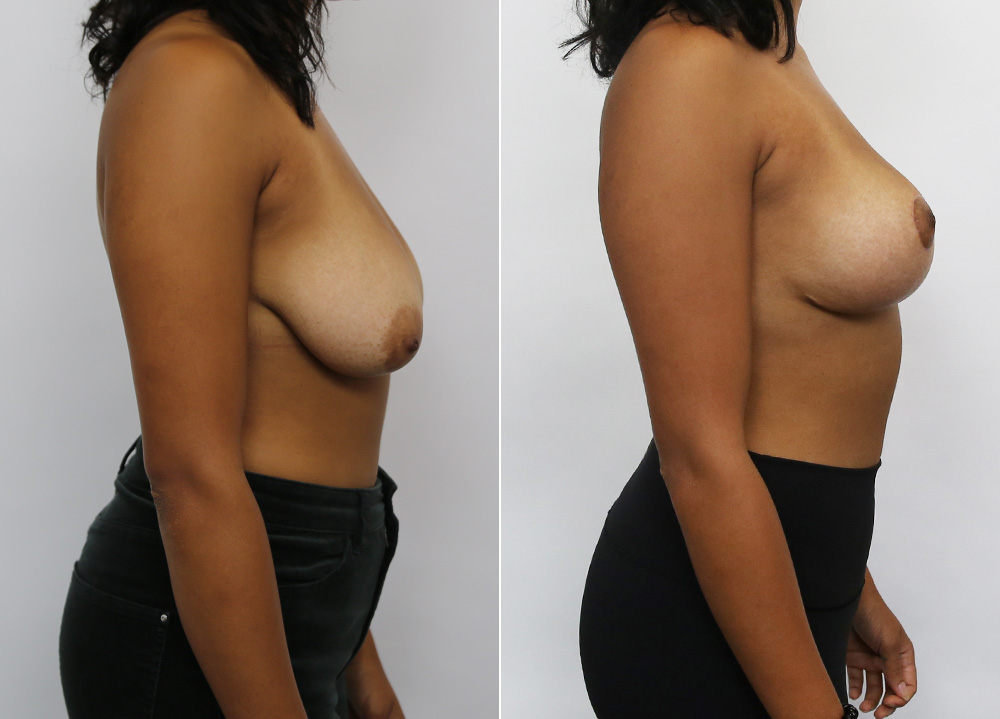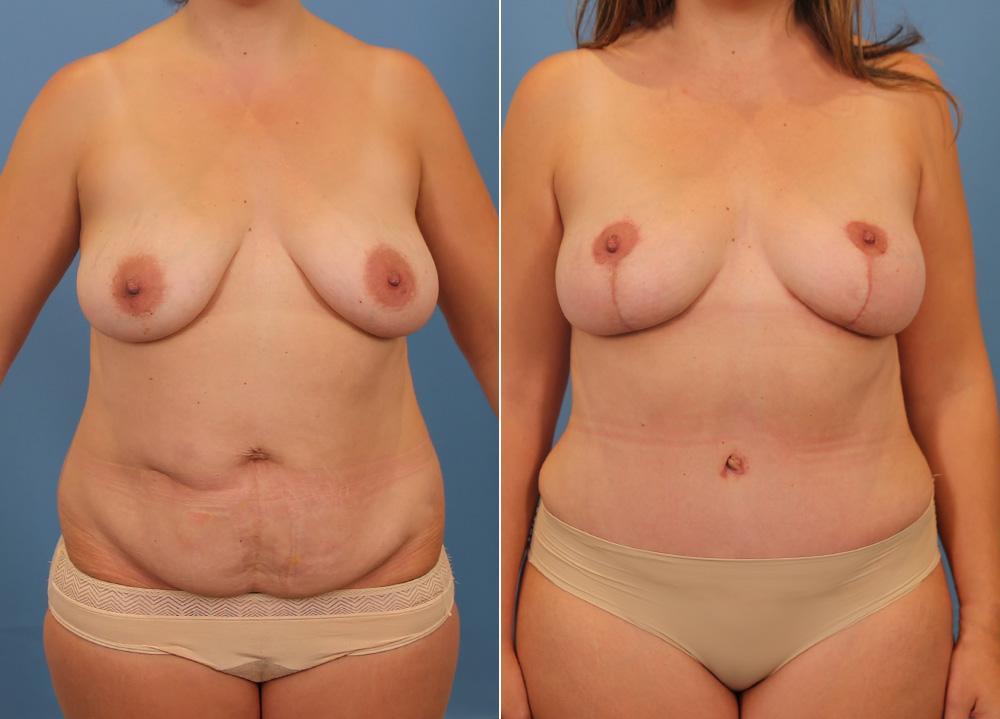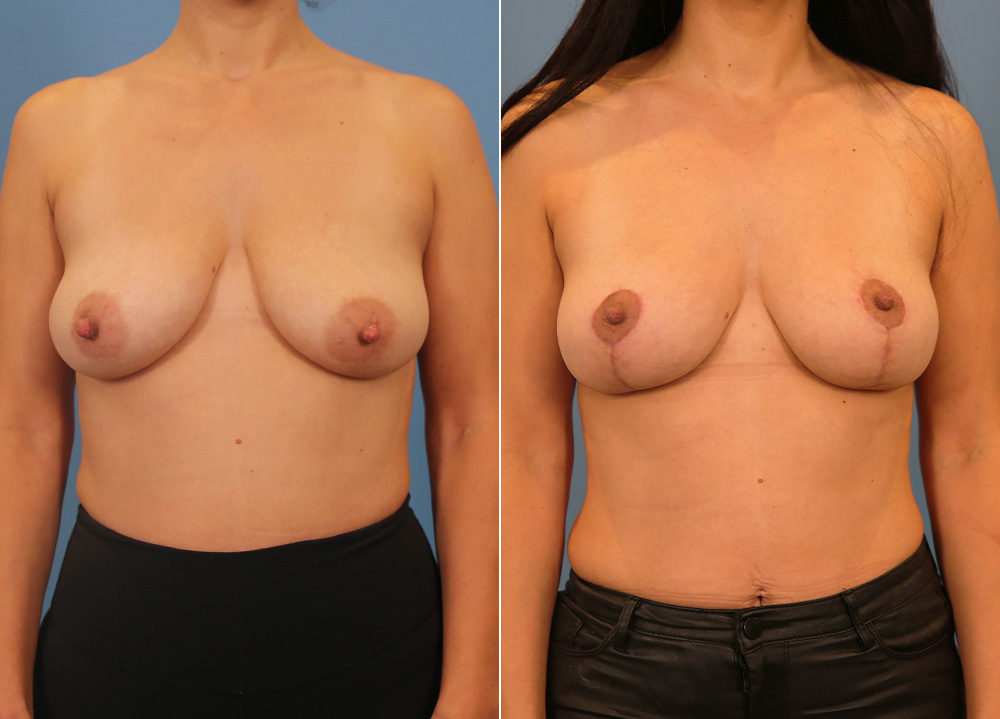


DO YOU FEEL LIKE YOUR BREASTS HAVE LOST SHAPE AND VOLUME?
A breast lift (or mastopexy) is performed to correct droopy or saggy appearing breasts, creating fuller and perkier breasts. It involves lifting the position of the nipple and often increasing the breast volume, especially in the upper part of the breasts.
Losing breast volume is a normal part of the ageing process and is particularly common after having children, breastfeeding and losing weight. When this happens, an implant is often needed to give you back that lost volume and shape.
Whilst the operation is usually performed in a single stage, it sometimes may need to be performed in two stages usually with patients who have had massive weight loss.



Who may consider this procedure?
Some adults may choose mastopexy for reasons such as:
Breast sagging due to aging, pregnancy, breastfeeding, weight fluctuations, or loss of skin elasticity.
Asymmetry between breasts in terms of position or shape.
Surgery is not medically required; non-surgical options or no treatment may be appropriate alternatives.
FREQUENTLY ASKED QUESTIONS ABOUT OUR BREAST MASTOPEXY PROCEDURES
Anaesthesia: Typically general anaesthesia.
Technique: Removal of excess skin, reshaping of breast tissue, and elevation of the nipple‑areolar complex. The areolar size may be adjusted when needed.
Incisions: Selected based on sagging severity and aesthetic planning.
Duration and setting: Usually a day‑surgery procedure, though complexity or combined procedures may require overnight stay.
No mastopexy can guarantee a specific outcome, and techniques vary per individual anatomy.
No surgical intervention.
Supportive garments or bras (though they do not necessarily prevent ptosis)
Combined procedures such as augmentation‑mastopexy or reduction‑mastopexy when clinically indicated.
Your surgeon will review your medical history, examine breast tissues and degree of ptosis, and discuss incision and reshaping options. Common surgical techniques include:
Vertical (“lollipop”) incision for moderate sagging
Anchor (“inverted‑T”) incision for more extensive sagging or combined procedures
A detailed explanation of potential risks, recovery, and alternatives will be provided in writing as part of informed consent.
Expect initial swelling, bruising, and discomfort, usually managed with prescribed analgesics. Many patients resume light activities within 1–2 weeks; avoid strenuous upper‑body activity for approximately 6 weeks. Results typically stabilize over 3-6 months.
If pre- and post-operative images are shown on this site, they are provided for general information only and do not predict your outcome. Images are displayed using comparable lighting, positioning, background, and clothing where possible. Any gallery contains a prominent notice stating that results vary due to factors including individual anatomy and healing. Images are not digitally altered other than standard anonymisation and sizing for web display.
Dr Alex Phoon Specialist Plastic Surgeon
AHPRA registration number: MED0001587102
Registration type: Specialist registration
Recognised specialty: Plastic & Reconstructive Surgery
Patients may verify registration via the AHPRA public register.
All surgical procedures carry risks. Specific to mastopexy, these may include but are not limited to:
Anaesthetic risks, infection, bleeding, delayed healing, seroma, and scarring (including hypertrophic or keloid scars).
Changes in sensation of the nipple or skin-temporary or permanent.
Asymmetry, contour irregularities, or wound dehiscence.
Scarring that may not fade completely; healing varies by individual.
Rare but serious risks such as blood clots (DVT/PE) or death.
A comprehensive written risk summary will be provided during consultation.
It is essential that all risks & complications of surgery are understood before proceeding. For more information on risks & complications please visit our web page on Risks & Complications of Cosmetic Surgery – Dr Alex Phoon
Mastopexy results may diminish over time due to aging, gravity, pregnancy, or weight changes. Future surgery may be necessary. No surgical result is permanent or guaranteed.
Repositioning the nipple from a lower to a higher position requires a circumferential scar around the nipple and areola, along with a vertical incision below it. This pattern is commonly referred to as a lollipop incision. In some cases, this may be combined with a horizontal incision in the crease under the breast, which is also used when placing implants.
If the breasts are lower-set with more excess skin, the horizontal crease incision may need to be longer, creating what is called an anchor or inverted-T incision. Scarring is an unavoidable part of surgery. While scars generally fade over time, their appearance varies between individuals. Surgeons may recommend scar management strategies such as taping or silicone dressings to support the healing process.
The cost of surgery varies depending on individual circumstances and the specific surgical requirements. These details will be discussed during your consultation, once a tailored treatment plan has been developed.
Factors that may influence the overall cost include:
- Whether your procedure is deemed cosmetic or medically required
- Theatre time
- Length of hospital stay
- Private health fund status (if the procedure is deemed medically necessary)
- Eligibility for item numbers.
- An itemised quote will be provided to you following your consultation with Dr Phoon.
Many patients ask about when they can safely return to exercise after surgery. Physical activity should be avoided in the early recovery period, and most surgeons recommend waiting at least six weeks before resuming strenuous exercise. Returning too early may increase the risk of implant movement, particularly with anatomical (teardrop-shaped) implants. Supportive garments are usually provided and should be worn as directed to assist with recovery.
One of the most common procedures combined with augmentation mastopexy is an abdominoplasty (tummy procedure). The abdominal area, like the breasts, can change significantly following pregnancy or major weight loss. In some cases, patients may consider addressing both areas in a single operation, depending on their individual circumstances and overall health.
These combined procedures can address both functional and aesthetic concerns, such as removing excess skin while reshaping the breasts. The decision to combine procedures depends on several factors, including patient goals, anatomy, and safety considerations, and should be discussed in detail with the surgeon.
This procedure is often performed as day surgery, although an overnight stay may be recommended if it is combined with another operation. Many patients take about a week away from work, with the first few days typically being the most uncomfortable. Pain relief medications are usually prescribed to assist during the recovery period.
Swelling is common in the first few weeks, and it may take 6–8 weeks before the breast shape starts to settle, although recovery and results vary between individuals. The likelihood of needing revision surgery is generally higher with augmentation mastopexy compared to breast augmentation alone.
All mastopexy (breast lift) procedures involve some scarring on the breast. The primary aim of the surgery is to reposition the nipple and reshape the breast. When the procedure mainly involves nipple repositioning without altering breast size, a keyhole or “lollipop” incision pattern may be used. If more tissue adjustment is required, such as in larger breasts, an additional incision in the breast crease may be necessary to remove excess tissue and support reshaping.
Breast lifts (mastopexy) and breast reductions are similar procedures. Both involve reshaping the breast and repositioning the nipple to a higher location. The main difference is that in a breast reduction, additional breast tissue is removed as part of the reshaping process.
In some cases, an implant may be placed at the same time as a breast lift to increase upper breast volume. This combined procedure is called an augmentation mastopexy. While it can sometimes be performed in a single stage, in certain situations—such as with very large breasts, a low nipple position, or significant weight loss—a staged approach may be recommended to support a more reliable outcome. The most appropriate option depends on individual anatomy and surgical considerations, and should be discussed with your surgeon.
In some cases, it may be possible to use a patient’s own breast tissue to reshape and add volume higher within the breast. This is known as auto-augmentation. Another option is fat grafting, where fat is taken from another part of the body using liposuction techniques, processed, and then injected into the breast. Not all of the transferred fat survives long term, and further procedures may be needed if additional volume is desired.
Risks and complications of cosmetic surgery
Cosmetic surgery is a form of surgery and, like all surgical procedures, carries risks and potential complications. It is important that anyone considering cosmetic surgery is provided with accurate and complete information about these risks before deciding whether to proceed.
Dr Alex Phoon is an Australian specialist plastic surgeon (specialist registration in Surgery – Plastic Surgery, AHPRA registration number: MED0001587102). He performs cosmetic and reconstructive procedures in accredited hospital facilities with appropriately qualified surgical, anaesthetic, and nursing teams.
This page outlines general categories of risks and complications that may be associated with cosmetic surgery. A full discussion of risks specific to an individual procedure will be provided in writing and during consultation as part of the informed consent process.
Scarring
Scarring is a common concern for people considering cosmetic surgery. All surgery results in some form of scarring, and while techniques are used to help reduce its appearance, it cannot be completely avoided. The extent and visibility of scars vary between individuals and depend on factors such as the type of surgery, healing response, and skin characteristics.
Read moreThe severity and appearance of scars can vary from person to person and depend on the type of procedure performed. Factors such as genetics, skin type, and individual healing responses can influence how noticeable scars may be. In many cases, scars may become less prominent over time, but this process is highly individual.
Scarring is a normal part of the body’s healing process. When the skin is cut or injured, the body forms new collagen fibres to repair the area. This healing response creates a scar, which may differ in colour and texture from the surrounding skin.
Different types of scars may occur after cosmetic surgery. For example, hypertrophic scars are raised, thickened areas that may be red or itchy. Keloid scars, which grow beyond the boundaries of the original wound, can occur in some people and may be more common in those with darker skin tones.
While surgical techniques aim to minimise tension on the skin and place incisions in less visible areas, scarring cannot be completely avoided. Patients are often advised to follow post-operative instructions carefully, which may include wound care, the use of silicone gels or dressings, and sun protection.
In some situations, scar management or revision procedures may be discussed. These may include treatments such as laser therapy, dermabrasion, or surgical excision. The choice of treatment depends on the type of scar and individual circumstances, and outcomes can vary.
It is important to have realistic expectations about scarring before undergoing surgery. Scars cannot be eliminated, but there are options to help improve their appearance. Patients are encouraged to raise any questions or concerns with their surgeon, so they can make an informed decision about the procedure and understand the potential risks and management strategies.
Infection
Infection is a potential risk of any surgical procedure, including cosmetic surgery. Although strict sterilisation and infection-control protocols are followed, it is not possible to remove this risk entirely. The likelihood and severity of infection can vary depending on individual factors and the type of procedure performed.
Read moreTo help reduce the risk of infection, surgeons may use antibiotics, follow strict aseptic techniques, and monitor patients for any signs of infection. Patients also play an important role in their recovery by carefully following post-operative care instructions, which can assist in lowering the risk of complications.
Infection is a recognised risk of all surgical procedures, including cosmetic surgery. Any time the skin is cut, there is an entry point for bacteria and other microorganisms. Although healthcare professionals follow strict sterilisation protocols to reduce this risk, it cannot be completely eliminated.
To help lower the likelihood of infection, surgeons may use antibiotics, follow strict aseptic techniques during surgery, and monitor patients carefully afterwards. Antibiotics may be prescribed before and/or after the operation, depending on the procedure and the patient’s individual medical circumstances.
During surgery, precautions such as using sterile instruments, maintaining a controlled environment, and wearing protective clothing are followed to help reduce the introduction of bacteria into the surgical site. Even with these measures, infections can still occur, which is why ongoing monitoring and early management are important.
Patients also play an important role in their recovery. Following post-operative instructions-such as keeping the surgical site clean and dry, avoiding activities that could interfere with healing, and promptly reporting any signs of infection (for example redness, swelling, pain, or discharge)-can assist in reducing the chance of complications.
While the risk of infection cannot be removed entirely, these combined strategies-both by the surgical team and the patient-are designed to support safer recovery and allow for timely management if infection develops.
Pain
Pain and discomfort are common after cosmetic surgery. These symptoms can vary between individuals and procedures, but strategies such as prescribed pain relief and supportive care are often used to help manage them.
Read moreThe level of pain experienced after cosmetic surgery can vary depending on the type of procedure, an individual’s pain threshold, and their healing response. Pain relief medications are often prescribed to help manage discomfort during recovery. Patients are encouraged to communicate openly with their healthcare team about their pain, as effective management is an important part of the recovery process.
Undesirable cosmetic outcome
Although cosmetic surgery is performed with the intention of improving appearance, there is a risk that the final result may not meet a patient’s expectations or may differ from the anticipated outcome.
Read moreOutcomes can be influenced by many factors, including individual healing responses and the expectations a patient brings to surgery. It is important for patients to have open and thorough discussions with their surgeon about what results are realistically achievable and any potential limitations. In some cases, further procedures may be considered if the initial outcome does not meet expectations.
Nerve damage
Nerve injury is a possible complication of cosmetic surgery.
Read moreSurgeons take care to minimise the risk of nerve injury during procedures, but this risk cannot be removed entirely. Nerve damage may result in altered sensation such as numbness, tingling, or reduced sensitivity in the area of surgery. In some cases, these changes improve over time, although recovery can vary and some effects may be long-lasting. Patients are encouraged to discuss this risk with their surgeon before making a decision about surgery.
Bruising and swelling
Bruising and swelling are expected effects after cosmetic surgery, especially during the initial stages of recovery.
Read moreBruising and swelling are part of the body’s normal healing response after surgery. Measures such as compression garments, elevation, and cold compresses may be recommended to help manage these effects. Although usually temporary, bruising and swelling can cause discomfort and may influence the recovery process. Following post-operative care instructions can assist in supporting recovery, but the duration and severity of these symptoms vary between individuals.
Bleeding
Bleeding during or after surgery is a possible complication of any surgical procedure, including cosmetic surgery.
Read moreSurgeons use techniques during surgery to help control bleeding, but some post-operative bleeding can still occur. Patients should contact their healthcare provider if bleeding seems excessive or does not improve with gentle pressure. In rare cases, more significant bleeding may require further treatment in hospital, which can include additional procedures or, occasionally, a blood transfusion.
Seroma
A seroma is a collection of fluid that may develop under the skin following surgery.
Read moreSeromas form as part of the body’s inflammatory response and are more common after larger surgical procedures. They may cause swelling or discomfort. To manage this, surgeons may use drains during surgery or remove fluid afterwards through a procedure called aspiration. While these measures can help reduce the likelihood of fluid build-up, seromas can still occur. Regular follow-up and monitoring allow for timely detection and management if they develop.
Anaesthetic complications
Complications related to anaesthesia are uncommon but can occur with any surgical procedure, including cosmetic surgery.
Read moreAnaesthesia is used during surgery to manage pain and keep patients comfortable. The risks associated with anaesthesia can vary depending on individual factors such as medical history, allergies, and overall health. Anaesthetists are specialist doctors who monitor patients throughout the procedure and use established techniques to help reduce these risks, although complications can still occur.
Death
Although rare, death is a possible risk with any surgical procedure, including cosmetic surgery. It is important for patients to be aware that all surgery carries inherent risks.
Read morePatient safety is a key focus in cosmetic surgery. Preoperative assessment, careful surgical planning, and adherence to established protocols are important in helping to reduce risks. Patients are encouraged to discuss their individual concerns and circumstances with their surgical team.
In conclusion, while cosmetic surgery may change a person’s appearance, it also carries risks and potential complications. Understanding these risks and discussing them openly with a surgeon supports informed decision-making and realistic expectations. Following post-operative care instructions and maintaining clear communication with the healthcare team can also play an important role in recovery.




